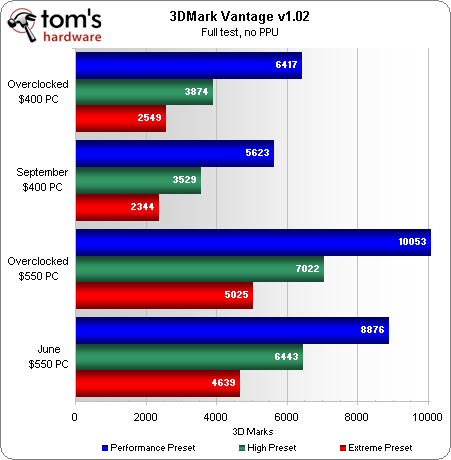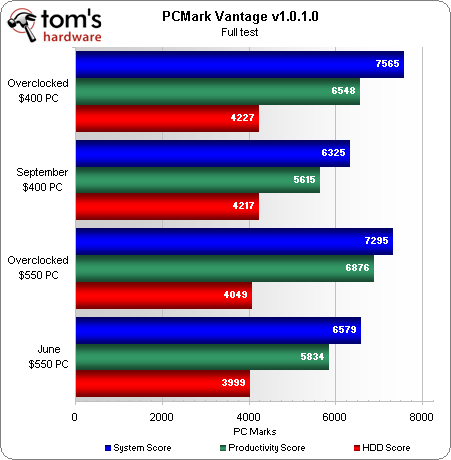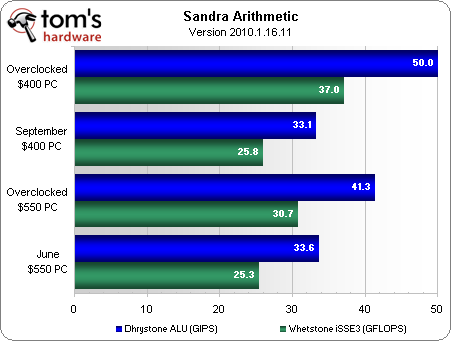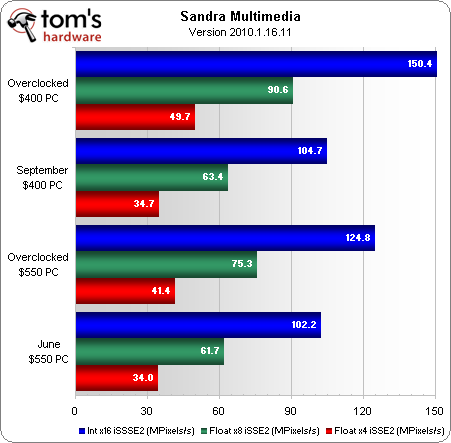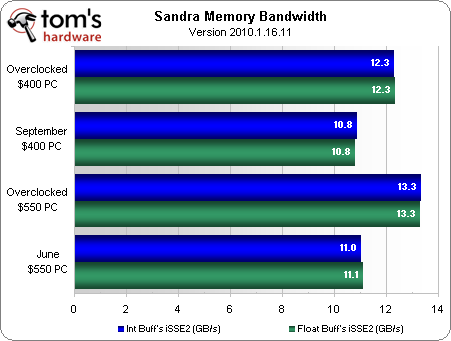System Builder Marathon, Sept. 2010: $400 Gaming PC
Benchmark Results: Synthetics
There weren’t any changes to our benchmark suite this month, so we’ll be able to make direct comparisons to data gathered in June.
Stepping down from a Radeon HD 5770 to a Radeon HD 5670 is huge, so this 3DMark blowout isn’t really a surprise. The extra 2800 point CPU score favoring the unlocked quad-core September PC, in the end, does little to counteract realizing 50% of the former $550 rig’s GPU score.
PCMark Vantage depicts slightly better overall system performance for last quarter's configuration, but a victory for the $400 PC once both are overclocked. The current build was edged out in productivity software, but held a slight lead in storage performance.
For Sandra’s processor and memory tests, we’re basically comparing two very similar system configurations. Different motherboards both based on the AMD 770/SB710 chipset, the same RAM, and an Athlon II X3 CPU separated by roughly 100 MHz (closer to 92 MHz, due to fractional reference clock variations).
The $550 PC overcomes its lower processor frequency and matches the stock September PC in the Processor Arithmetic test, but not in the Multimedia test. Once overclocked, the $400 machine’s four cores completely win out over June’s higher frequency three-core overclock.
Both systems have Crucial DDR3-1333 memory at 9-9-9-24 1T timings and in unganged mode, but we see a slight memory bandwidth advantage favoring the $550 PC. The overclocked systems share the same basic 8-8-8-24 1T memory timings, but otherwise differ with the $550 PC employing a lower memory frequency, higher northbridge frequency, and higher HyperTransport link speed.
Get Tom's Hardware's best news and in-depth reviews, straight to your inbox.
Current page: Benchmark Results: Synthetics
Prev Page Test System Configuration And Benchmarks Next Page Benchmark Results: Audio/Video-
SpadeM ReplyGiven the motherboard’s basic passive cooling measures, though, there was really no point in putting more time into lowering the CPU multiplier, pushing a high reference clock, and attempting to maximize northbridge and memory frequencies.
+1 for making this statement, glad someone considered it at least. All in all decent build for the money. -
AMW1011 I'll be honest, I think a $450 budget is a little more reasonable than a $400 budget. At that price a 5750 or even a 5770 can be had, which would have worked fine with all of the other parts and likely would have matched the $550 June build.Reply
Even this $400 build packs a punch, you can get one HELL of a rig for the money any more. It really is insane, and that's not even considering the used or refurb market!
Awesome article, probably one of my favorite SBM, atleast the best I've seen in a long time. -
micr0be very nice build, interesting to see how much performance can be squeezed out of the budget. i was expecting worse results.Reply -
Gamer-girl ReplyIt went $1 over-budget if we substituted in a GeForce 9800 GT.
I doubt someone spending $400 can't afford to add an extra dollar. although i realize that the point in these articles is to stay under the budget, it would have been interesting to see the price/perforamce difference. -
haplo602 nice case, looks very good ... pity that rosewill does not have a downloadable manual for it ...Reply -
HibyPrime I'd be interested to know how much more overclocking headroom you could pull out of it if you left it at 3 cores - and would that net you more performance in most of the benchmarks?Reply
I'd bet if you could pull ~200 mhz more out of it, it would begin to match up with the missing core, and maybe start to pull away around 400mhz. -
Proximon The Cooler Master Elite 460 is a falsely labeled piece of crap. You can find the review (with proper testing) here: http://www.hardwaresecrets.com/article/1005/1Reply
You'll have to spend a little bit more there. Rosewill has a 430W (RG430 S12) unit or the Antec Neo 400W is almost the same price as the CM after a discount and rebate.

